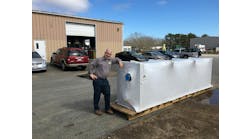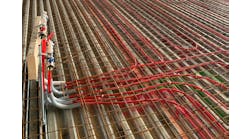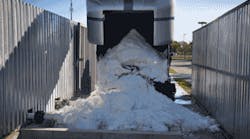PEMBROKE PINES, FLA. — By installing a liquid desiccant air conditioning system and tapping into renewable energy sources, including Zamboni ice shavings, Pines Ice Arena, Pembroke Pines, Fla., has achieved 55% energy savings, improved air quality, and lower maintenance requirements. During a full year of operation, the arena is expected to reduce total energy and water costs by more than 60% compared to previous years.
Pines Ice Arena is one of the largest recreational ice rinks in South Florida with two rinks, 12 party rooms, a full size gym, retail store and offices. The 80,000-sq.ft. facility holds approximately 2,000 people and reaches full capacity twice a week.
Previously, the arena operated with a standard chiller and dehumidification system. Gas and electric expenses averaged more than $389,000 per year (approximately 90,000 kWh and 60,000 therms of gas), and water consumption averaged $31,000 per year. Rising energy costs accounted for a major portion of Pines’ operating budget. Plus, the arena struggled to maintain optimal ice conditions.
“With rising energy costs, our facility was becoming very costly to maintain,” explained Shlomo Epstein, owner of Pines Ice Arena. “The refrigeration bill was extremely high during the hot, humid months, the two cooling towers used over 6 million gallons of water every year, and the desiccant wheels’ maintenance was costly. I knew I had to find an alternative solution that would consume less energy, assure excellent ice quality and also save money on the maintenance. This ice rink serves the community and we wanted to do our part to be a responsible business owner.”
By installing six Advantix DuHandling units, located on the roof, which are powered using both waste heat from cogeneration via a microturbine and cooling from a ground source cooling well, Pines Ice Arena reduced energy consumption by 55%, lowered maintenance costs and achieved optimal air quality in less than a year, according to Trevor Wende, vice president of Advantix Systems.
Advantix Systems’ cooling and dehumidification systems are based on liquid desiccant’s natural removal of moisture from the air. The non-toxic, brine solution cools, dehumidifies and cleans the air at the same time without needing to be replaced and without exiting the system. When heated, the liquid desiccant releases the moisture back outside in the form of water vapor, eliminating collection of water condensate from any point in the system.
Once the units were installed, Pines was able to remove one chiller and one cooling tower and eliminate both desiccant wheels. The one remaining cooling tower is used as a back up system if needed. The DuHandling units also leverage alternative energy sources to cool and heat the liquid desiccant for cooling and dehumidification.
Heating, cooling sources
For cooling, the ice resurface waste from the Zamboni is dumped into an ice pit to assist with cooling the liquid desiccant. And a geothermal well designed by Advantix engineers is also used for cooling.
“The ice shavings is a technique developed by us which we have used before,” said Wende. “The ice savings amount to approximately 10 cubic meters of ice per day, the equivalent of 20 ice-sheet cleanings per day.”
The open-loop geothermal well was designed by Advantix and is approximately 65-ft deep. A Grundfos pump circulates the water and custom-built heat exchangers from Forkor are being utilized in the system. The geothermal pipe was spec’ed as standard schedule 80.
According to Wende, geothermal was picked because water is delivered at 71°F, which is good for the cooling and dehumidification systems, and geothermal has very low energy costs along with minimal maintenance.
For heating, the waste water from the microturbine is utilized to heat the liquid desiccant and extract the humidity, and solar thermal panels, scheduled for Phase II of the project, will be utilized in the near future.
According to Wende, a Calnetix microturbine was picked as an energy source because an economic analysis identified cogen as the best option.
“A combination of relatively inexpensive natural gas plus the substantial non-HVAC electrical load meant that the arena would be able to fully utilize both the electrical and thermal output from the cogen with the thermal output being used by the Advantix Units to condition the air in the arena,” said Wende.
So far, savings from the renewable energy sources include a 55% drop in electricity consumption; a reduction in natural gas consumption by 35%; and a 17% decrease in water consumption.
According to Wende, the water savings is strictly due to utilizing the DuHandling units. Before the units were installed, water consumption was driven by the cooling towers, which are no longer necessary.
“The results of this new system have exceeded my expectations,” said Epstein. “I never imagined that I could save so much money in energy consumption by tapping into existing processes in our facility. Who knew that the Zamboni ice shavings dumped behind our building every day could be reused to cool the building? I’m proud that our ice rink is now a model in the community of Green Building alternatives.”
Related Articles:
Greenbuild 2010 showcases innovative solutions
Related Articles:
Hydronics brings comfort, efficiency to Alaska




